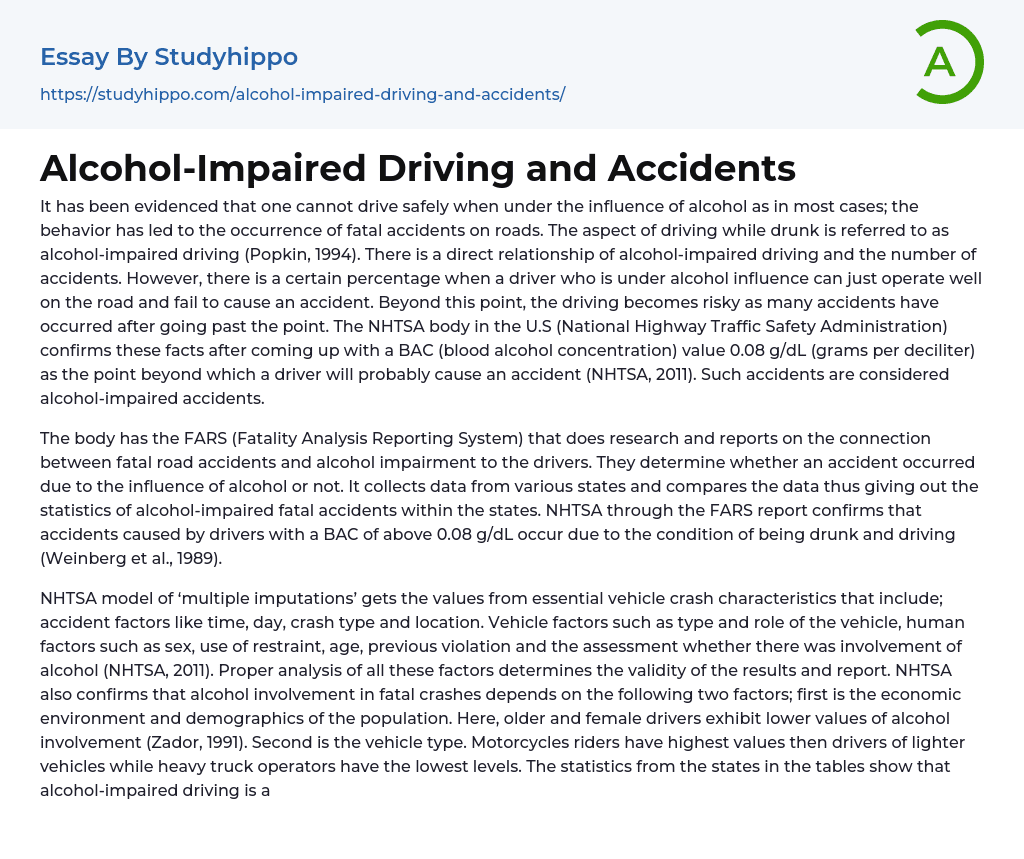It has been evidenced that one cannot drive safely when under the influence of alcohol as in most cases; the behavior has led to the occurrence of fatal accidents on roads. The aspect of driving while drunk is referred to as alcohol-impaired driving (Popkin, 1994). There is a direct relationship of alcohol-impaired driving and the number of accidents. However, there is a certain percentage when a driver who is under alcohol influence can just operate well on the road and fail to cause an accident. Beyond this point, the driving becomes risky as many accidents have occurred after going past the point. The NHTSA body in the U.S (National Highway Traffic Safety Administration) confirms these facts after coming up with a BAC (blood alcohol concentration) value 0.08 g/dL (grams per deciliter) as the point beyond which a driver will probably cause an accident (NHTS
...A, 2011). Such accidents are considered alcohol-impaired accidents.
The body has the FARS (Fatality Analysis Reporting System) that does research and reports on the connection between fatal road accidents and alcohol impairment to the drivers. They determine whether an accident occurred due to the influence of alcohol or not. It collects data from various states and compares the data thus giving out the statistics of alcohol-impaired fatal accidents within the states. NHTSA through the FARS report confirms that accidents caused by drivers with a BAC of above 0.08 g/dL occur due to the condition of being drunk and driving (Weinberg et al., 1989).
NHTSA model of ‘multiple imputations’ gets the values from essential vehicle crash characteristics that include; accident factors like time, day, crash type and location. Vehicle factors such as type and rol
of the vehicle, human factors such as sex, use of restraint, age, previous violation and the assessment whether there was involvement of alcohol (NHTSA, 2011). Proper analysis of all these factors determines the validity of the results and report. NHTSA also confirms that alcohol involvement in fatal crashes depends on the following two factors; first is the economic environment and demographics of the population. Here, older and female drivers exhibit lower values of alcohol involvement (Zador, 1991). Second is the vehicle type. Motorcycles riders have highest values then drivers of lighter vehicles while heavy truck operators have the lowest levels. The statistics from the states in the tables show that alcohol-impaired driving is a threat to road safety since many of the drivers under the condition get involved in fatal crashes than when in normal circumstances (TFCPS et al., 2001). If the statistics are valid, something ought to be done to reduce the aspect of alcohol-impaired driving.
References
- Brewer, R. D., Morris, P. D., Cole, T. B., Watkins, S., Patetta, M. J., & Popkin, C. (1994). The risk of dying in alcohol-related automobile crashes among habitual drunk drivers. New England Journal of Medicine, 331(8), 513-517.
- National Highway Traffic Safety Administration. (2011). Traffic safety facts 2009: a compilation of motor vehicle crash data from the
- Fatality Analysis Reporting System and the General Estimates System. Early edition. Washington, DC: US Department of
- Transportation, National Highway Traffic Safety Administration; 2010. National Center for Statistics and Analysis, US Department of
- Transportation, 20590. https://crashstats.nhtsa.dot.gov/Api/Public/ViewPublication/811776
- Shults, R. A., Elder, R. W., Sleet, D. A., Nichols, J. L., Alao, M. O., Carande-Kulis, V. G., & Task Force on Community Preventive
- Services. (2001). Reviews
of evidence regarding interventions to reduce alcohol-impaired driving. American journal of preventive medicine, 21(4), 66-88.
- Aircraft essays
- Renault essays
- Truck essays
- chrysler essays
- The city essays
- Racing essays
- Texting And Driving essays
- Air Force essays
- Army essays
- Army Values essays
- Soldiers essays
- United States Army essays
- Veteran essays
- Car Accident essays
- Bicycle essays
- Cars essays
- Rms Titanic essays
- Animal Cruelty essays
- Charles Manson essays
- Crime Prevention essays
- Crime scene essays
- Criminal Justice essays
- Criminology essays
- Cyber Crime essays
- Damages essays
- Detention essays
- Distracted Driving essays
- Drug Trafficking essays
- Drunk Driving essays
- Forensic Science essays
- Gang essays
- Hate Crime essays
- Homicide essays
- Identity Theft essays
- Juvenile Crime essays
- Juvenile Delinquency essays
- Juvenile Justice System essays
- Law Enforcement essays
- Murder essays
- Organized Crime essays
- Penology essays
- Piracy essays
- Prison essays
- Property Crime essays
- Prostitution essays
- Punishment essays
- Punishments essays
- Rape essays
- Robbery essays
- Serial Killer essays




